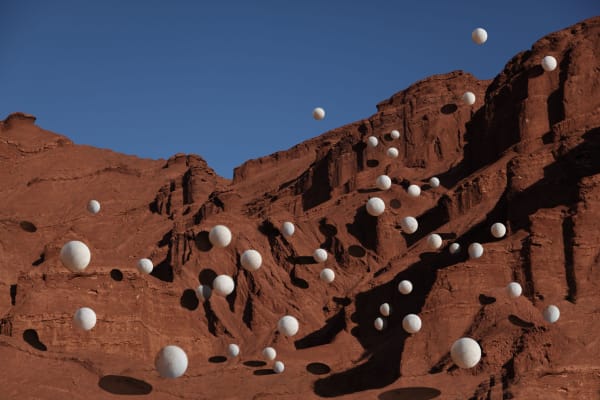Miguel Angel Ríos | A Trilogy
March 17, 2016 — San Francisco — For A Trilogy, Miguel Angel Ríos’ first exhibition with Gallery Wendi Norris, he will exhibit three of his most recent video works: Piedras Blancas, Mulas, and Landlocked. Ríos first became recognized in the late 1980’s and early ‘90’s for his paintings and collage works, and has since gone on to create video work that has influenced contemporary artists working today. The exhibition highlights his unique artistic practice that addresses issues of power, apathy and violence, while incorporating an innovative use of social and political narratives and original production techniques.
The new video projects are site-specific and grounded in an approach to Land Art, where Ríos challenges traditional modes of representations within the landscape – works that he describes as the most ambitious and challenging video projects of his career. The works are similar in that they all take place in the open, arid and mountainous landscapes of South America. To produce them, the artist worked under conditions that he describes as “difficult, dangerous, and impossible,” three qualities that are required to pique his interest in making an artwork. These projects are carefully conceived performances that rely on an impossible plot: the choreography of chance. In all of them, the artist works with gravity and mediates objects and/or animals to tell a story: white balls in Piedras Blancas, pack mules in Mulas, and stray dogs in Landlocked.
His experiments with video push the boundaries of a camera to its limits, and at times to its destruction. Some of these videos are based on his own childhood games from Argentina, translated into provocative works that explore societal issues related to his own vivacity and understanding of social life.
In the case of Piedras Blancas, the acting characters are more than 3,000 white cement balls handmade by the artist. The “white stones” loudly roll, bounce, and even careen down the side of a mountain, over existing paths with artery-like trails. One can view this action as a metaphor for the economic struggles surrounding present day migrations in Europe, or perhaps they symbolize drug trade routes taken from South to North America. With this work, Ríos questions “Are we witnessing some kind of game, or is it a catastrophe in the making?”
Mulas refers to Ríos’ on-going fascination with the conquest of Latin America by referencing Christopher Columbus who was the first to breed mules in the New World. In the video, two mules—half donkey, half horse—are seen carrying satchels slowly spilling a mysterious white powder that draws lines on the South America desert landscape as they cross narrow trails and unpopulated terrain. This automatist drawing of a white line recalls minimalist land art, but it has a political edge that suggests contemporary stories of narcotics trafficking. The mules in the video start by slowly climbing scenic mountains until the tone changes to a more sinister eruption edited almost like a symphonic poem leading into the abyss. The title, Mulas, references the Spanish slang for young women traffickers convinced to transport drugs across borders, under perilous conditions.
The third video, Landlocked, features a pack of four seemingly wild dogs that were in fact extensively trained by Ríos. The drama of the video is heightened by the screeching barking of the dogs and their urgency to get to the “other side” as they vigorously dig tunnels through a hillside at the foot of the Andes Mountains on the Western edge of Bolivia, impossibly working their way toward the Pacific Ocean. Their work appears as though it may be fruitless, a metaphor for the location of the country of Bolivia, extremely close to the ocean but without access to export goods by sea which severely impairs the country’s capacity to bring in revenue. The video also plays off thematics of labor, power and economy that are influenced by the recent discoveries of more than 80 tunnels found between Mexico and the United States.
Related paintings, works on paper, drawings and photographs all created in preparation for or alongside the videos will be on display as well, providing insight into the artistic process. After shooting video footage during the mornings and afternoons, Ríos spends his evenings making one painted or drawn work, a storyboard of a shot he envisions recording the following day.
-
 Miguel Angel Ríos, Taking a Break, 2014, color print, 19 1/2 x 13 inches (50 x 33 cm)
Miguel Angel Ríos, Taking a Break, 2014, color print, 19 1/2 x 13 inches (50 x 33 cm) -
 Miguel Angel Ríos, Landlocked, 2014, oil on Formica, 13 x 53 inches (33 x 134.6 cm)
Miguel Angel Ríos, Landlocked, 2014, oil on Formica, 13 x 53 inches (33 x 134.6 cm) -
 Miguel Angel Ríos, Piedras Blancas, 2014, ink and pencil on paper, 11 x 14 inches (28 x 35.7 cm)
Miguel Angel Ríos, Piedras Blancas, 2014, ink and pencil on paper, 11 x 14 inches (28 x 35.7 cm) -
 Miguel Angel Ríos, Piedras Blancas, 2014, color print, 26 x 39 3/8 Inches (66 x 100 cm)
Miguel Angel Ríos, Piedras Blancas, 2014, color print, 26 x 39 3/8 Inches (66 x 100 cm) -
 Miguel Angel Ríos, Piedras Blancas, 2013, pencil on paper, rubbing and cut out, 18 x 14 inches (46 x 35.5 cm)
Miguel Angel Ríos, Piedras Blancas, 2013, pencil on paper, rubbing and cut out, 18 x 14 inches (46 x 35.5 cm)







